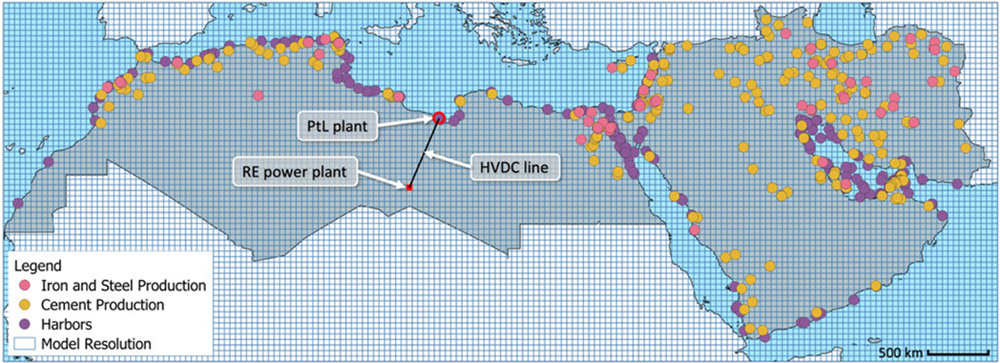Synthetic fuels for Europe's energy transition

- The study now published, “Costs and export potentials of green synthetic fuels produced in the MENA region”, describes the methodology used to determine the data, which were generated using the "GlobalFuel" model developed at DLR.
- According to the calculations, the export volume of cost-effective climate-friendly fuels could exceed 20 times Germany's annual demand as early as 2030.
- The calculation of production costs is based on an examination of the entire value chain - from power generation through electrolysis and carbon sources to fuel synthesis, taking into account storage and transport.
- Focus: Energy, system modelling, hydrogen, synthetic fuels
DLR researchers present structured potential and cost assessment for power-to-x fuel production in North Africa and the Middle East
The global energy transition requires solutions beyond the power socket. Especially for air and sea transport as well as industrial high-temperature processes, climate-neutral, energy-dense fuels are essential. A study by the German Aerospace Center (DLR) now shows where and at what costs such synthetic fuels can be produced in the future - and that the results offer a chance for a win-win situation of immense proportions for the countries of the Middle East and North Africa ("MENA" region) as well as for Europe's energy transition.
Using the DLR-developed model DLR_ITEMS "GlobalFuel", scientists from the Institute of Networked Energy Systems analysed the technical and economic potential for producing Fischer-Tropsch fuels (alternatives to diesel, kerosene, and gasoline produced through chemical processes using renewable energies) in 17 MENA countries. The results show: as early as 2030, around 3,400 terawatt-hours (TWh) of climate-friendly fuels could be produced cost-effectively (€190-220 per MWh) – with approximately 3100 TWh available for export. For comparison: Germany's demand in 2030 is estimated to be around 140 TWh, depending on the scenario. By 2050, the export potential could increase to over 5700 TWh at significantly lower costs (€120-140 per MWh), while Germany's demand is expected to be around 430 TWh.
Green fuels from sun and wind
The production of these synthetic fuels is based on the so-called Power-to-Liquid (PtL) process. Water and carbon dioxide are converted into liquid hydrocarbons using electricity. The fuels become climate-neutral when renewable energy is used for this process. Therefore, the study focuses on the use of photovoltaics (PV), concentrated solar power (CSP), and onshore wind power as energy sources.
For modeling, data with a spatial resolution of 50x50 kilometers and an hourly time scale were used. "On this scale, we considered not only the potential for sun and wind energy but also parameters such as local production costs and different technologies, as well as cost potentials and financial risks using the 'GlobalFuel' model," explains Jürgen Kern, scientific leader of the study. Particularly favorable conditions for the production of synthetic fuels prevail in Oman, Saudi Arabia, Egypt, Yemen, and Morocco, where production costs for synthetic fuels of less than €130 per megawatt-hour are possible by 2050.

Export potentials considering own demands
An essential element of the study is the realistic consideration of the MENA countries' own demands, as Kern emphasises: "Only if sufficient renewable energy is available for domestic consumption can surpluses be exported without jeopardising the country's own energy transition." The analysis shows that while large countries like Saudi Arabia, Oman, or Egypt will retain export potentials in the long term, smaller countries like Qatar, Bahrain, or Lebanon will have hardly any resources for building an export option after considering their own demands.
System costs and technology deployment in focus
A holistic approach was chosen for calculating production costs: the entire value chain – from electricity generation to electrolysis and carbon sources to fuel synthesis, including storage and transport – was mapped in a linear optimisation model. The costs of renewable energy generation and storage technologies are particularly significant: sustainable investments in generation and export infrastructure that meet both ecological standards and contribute to the socio-economic development of the countries are a basic requirement. The choice of CO2 source – whether from industrial processes or from the air through Direct Air Capture (DAC) – also affects total costs. Furthermore, the sustainable provision of water from seawater desalination plants was assumed.
Research contribution to europe's supply security
Although the study can only describe potentials and not necessarily projects: the methodology for determining the data will be made available to decision-makers, and the development of the "GlobalFuel" model will continue with the aim of applying it to other countries. The affected countries have already been directly involved in the process through supranational organisations such as the Association of Mediterranean Energy Regulators (MEDREG), the United Nations Industrial Development Organisation (UNIDO), the Economic and Social Commission for Western Asia (ESCWA), and the German Society for International Cooperation (GIZ), as well as with international industry representatives, and the results have been made available. They emphasise: the MENA region not only offers ideal natural conditions for the production of green energy but also real opportunities for building an international trade in climate-neutral fuels.
More Information:
- Scientific publication on the GlobalFuel model: Costs and export potentials of green synthetic fuels produced in the MENA region
- Scientific publication with the Wuppertal Institute on evaluating country-specific risks: Country risk impacts on export costs of green hydrogen and its synthetic downstream products from the Middle East and North Africa
- Middle East and North Africa: huge potential for hydrogen and synthetic fuels from renewable energies (DLR web news from 07.12.2022)
- Modeling tools: DLR_ITEMS - Integrated Techno-Economic Assessment Models
